How to Cite | Publication History | PlumX Article Matrix
Biodiversity of Some Economically Significant Stored Grain Pests in Jammu, Jammu and Kashmir
Neha Jamwal* , Sanjay Bhatia
, Sanjay Bhatia and Arti Sharma
and Arti Sharma
Department of Zoology, University of Jammu, 180006, Jammu and Kashmir, India
Corresponding Author e-mail: jamwalneha44@gmail.com
DOI : http://dx.doi.org/10.13005/bbra/2984
ABSTRACT:
The stored grain pests infest grains and other pantry items to fulfill their food and shelter requirements leading to both qualitative and quantitative losses. Due to favorable climatic conditions of Jammu, these stored grain insects register their presence throughout the year. These insects destroy and contaminate kitchen commodities with their fecal matter and undesirable odors and make them unpalatable, thus, posing a grave health hazard. Due to this reason, the post-harvest loss in India accounts for about 10% of the total grains and 9.5% of total pulses. The insects were collected randomly from places like super markets, grocery shops, ration depots, godowns, warehouses, etc. and were preserved in fumigated collection boxes using standard entomological procedures. From the study area, 16 insects under two orders namely Coleoptera (81.25%) and Lepidoptera (18.75%) were recorded on Pantry commodities within human dwellings in Jammu from 2017-2018. Of these, 9 insects have been recorded for the first time in the district, all of which belong to order Coleoptera. This is the first ever documentation of insect pests associated with stored grains from the Jammu district. However, this pilot study, which represents miniscule fraction of insect diversity in homes, requires a detailed and full scale investigations from the Jammu district, which is intended to be taken in further studies among these group of insects.
KEYWORDS: Household Insects; Post-Harvest Loss; Pantry Insects; Stored Grain Insect Pests
Download this article as:| Copy the following to cite this article: Jamwal N, Bhatia S, Sharma A. Biodiversity of Some Economically Significant Stored Grain Pests in Jammu, Jammu and Kashmir. Biosci Biotech Res Asia 2022;19(1) |
| Copy the following to cite this URL: Jamwal N, Bhatia S, Sharma A. Biodiversity of Some Economically Significant Stored Grain Pests in Jammu, Jammu and Kashmir. Biosci Biotech Res Asia 2022;19(1). Available from: https://bit.ly/3KKXIAv |
Introduction
Insect pests ravage upon many stored grains/pantry commodities fulfilling their food and shelter requirements, resulting in qualitative as well as quantitative loss. The tropical climate of India exhibit agreeable conditions for these pests throughout the year. A number of insect pests tend to make way inside grain storage at almost any stage of processing of food. Some insect pests start damaging at the mature stage of crops and continue the damage while storage as well. Major infestation is beheld upon old containers, bags, cross over infestation and faulty storage structures1. Nearly around 1000 species of insects have been related with stored grain products in different regions worldwide. These may render the grains rancid and adulterate the rest with nasty flavours and odours. Orders Coleoptera and Lepidoptera are the major stored / pantry insect pests2. Based on their feeding behavior, these insects can be sorted as external and internal feeders3.
External feeders
feed inside the germplasm and endosperm from outside attacking whole seed leading to damage in the germinal portion, feed on the seeds, which have already been damaged by other insects, or broken mechanically. These insect pests or their stages are generally visible among the seeds e.g. Tribolium castaneum, Cryptolestes sp., Oryzaephilus surinamensis, etc.
Internal feeders
mostly lay eggs inside or on the surface of grains, spend a part or entire life inside the grains, and emerge as adults. This lead to significant loss of germination, which remains undetected from outside e.g. Sitophilous oryzae, Callosobruchus sp., Ephestia cautella etc.
The insects associated with stored grains are of much concern, as they deteriorate the stored commodities inside our homes particularly infesting stored grains, processed food, spices, dry fruits, flour, pulses, soya products, etc. They cause significant damage to the grains wherein the highest intensity of damage is caused due to the larvae, although, adults also damage in some cases. The damage caused by these insects effect the overall grain production and in India, the postharvest loss account for 12 to 16 million metric tonnes of food grains each year4. Worldwide loss due to stored grain insect pests has an estimate between 5% – 10% but surplus loss can reach upto 30% of production. The stored grain insects are accountable for a loss worth a minimum US$200 million per year in USA5. About 5%-10% loss of stored grains has been estimated worldwide which may reach up to 30% in extreme cases. Huge damage to stored rice has been acknowledged by 36.92% farmers in Africa6. In India, due to a typical staple food diet, storage of cereal and pulses becomes extremely important in homes and in godowns. Infestation of grains from field to storage units is a huge matter of concern. Possibly, the reason could be their packing in infested gunny bags, godowns already infested by insects and improper storage7. Despite being able to produce million tonnes of food grains every year, still hunger and poverty prevails in India because much share of these grains is damaged due to environmental factors accompanied by infestation of stored grain insect pests and lack of the knowledge of scientific methods of storage adds another advantage in favour of these insects. Therefore, a collective loss of about 25% of food grain in the world is incurred upon by all these associated factors, highest in tropical and sub-tropical areas due to favourable growing conditions. Further, the annual loss of about 8% – 10%, is witnessed on the store commodities, worldwide8. Two orders of insects are worldwide known to be economically important post-harvest insect pests i.e., Coleoptera and Lepidoptera9. A study on storage management in India deciphered that India incurs about 12-16 million metric tons of post-harvest loss which accounts for 10% loss in the country10. Food Corporation of India in one of its recent report (2018) recorded that these pests destroy grains worth Rs.20, 000 crores in India annually. The present work, therefore, holds immense importance in enlightening masses against the insect pests and the problems that accompany them.
Material and Method
Collection, Preservation and Storage
The insects, along with their immature stages, were collected and sampled from various human dwellings and associated concerns like super markets, grocery shops, ration depots, godowns, warehouses, etc. in various parts of Jammu district using standard entomological procedures. The data was collected on monthly basis in order to obtain the seasonal availability of the insects so that the maximum infestation rate by these pests can be deciphered. Investigations with regard to distribution, habitat, host, external appearance, biology, seasonal availability and damage caused, by the recorded 16 insects, was studied. Part of the collected insects were stored by pinning using entomological pins, in fumigated collection boxes for subsequent morphological studies and for determining their taxonomic status while the rest were used for culturing in the laboratory and recording biological observations.
Morphological and morphometrical studies
General morphological description of all the insects and their stages were made using different magnifications of stereomicroscope, Model: Magnus MSZ-TR. Measurements were made using occulometer calibrated against the stage microscope on the total body length of the adults and immature stages of the insects. However, wherever required, standard graphic paper method of measurement was also applied.
Identification of insects
The collected insects were identified through the courtesy of different agencies with special reference to Entomology Division, IARI, New Delhi; in consultation with experts and also using standard online entomological databases and taxonomical keys put forward by Thomas, 1988 and Rees, 2004.
Results
From the present studies, 16 stored grain insects were recorded (Table. 1, Fig. 1), belonging to 2 orders (Fig: 1) of which 11 insects (71%) were reported to be internal feeders and only 5 insects (29%) were recorded as external feeders (Table. 1).
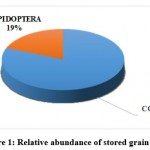 |
Figure 1: Relative abundance of stored grain pests |
Table 1: List of Stored Grain Insects recorded from Jammu District
| S.no | Name of the insect | Order | Common Name | Feeding guild |
| 1. | Tribolium castaneum | Coleoptera | Rust Red Flour Beetle | External feeder |
| 2. | Tribolium confusum | Coleoptera | Confused Flour Beetle | External feeder |
| 3. | Rhyzopertha dominica* | Coleoptera | Lesser Grain Borer | Internal feeder |
| 4. | Oryzaephilus surinamensis* | Coleoptera | Saw-toothed Grain Beetle | External feeder |
| 5. | Callosobruchus chinensis | Coleoptera | Bean weevil | Internal feeder |
| 6. | Callosobruchus maculatus* | Coleoptera | Cowpea weevil | Internal feeder |
| 7. | Callosobruchus analis* | Coleoptera | Pea weevil | Internal feeder |
| 8. | Lasioderma serricorne* | Coleoptera | Cigarette Beetle | Internal feeder |
| 9. | Stegobium paniceum* | Coleoptera | Drugstore Beetle | Internal feeder |
| 10. | Sitophilus oryzae | Coleoptera | Rice weevil | Internal feeder |
| 11. | Sitophilus zeamais* | Coleoptera | Maize weevil | Internal feeder |
| 12. | Gibbium psylloides* | Coleoptera | Spider Beetle | External feeder |
| 13. | Cryptolestes ferrugineus* | Coleoptera | Flat Grain Beetle | External feeder |
| 14. | Corcyra cephalonica | Lepidoptera | Rice Moth | Internal feeder |
| 15. | Plodia interpunctella | Lepidoptera | Indian Meal Moth | Internal feeder |
| 16. | Ephestia cautella | Lepidoptera | Almond Moth | Internal feeder |
*indicates new reports.
Discussion
Their nature of damage along with other details has been discussed in the following section:
Tribolium castaneum (Herbst, 1797)
Common Name: Rust Red Flour Beetle (Fig. 2). Systematic Position: Order: Coleoptera; Family: Tenebrionidae Distribution: Worldwide in distribution4, 11.
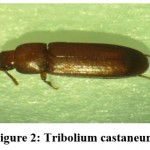 |
Figure 2: Tribolium castaneum |
Description and Identifying Characters
Reddish brown in colour and measures about 5 mm -6 mm in length. Antennae club shaped. Probably, the most dangerous stored grain pests. The antennae have three prominent clubs. These huddle themselves under the stacked products, preferring moist and humid places inside the kitchen.
Seasonal Availability: April – October. Pest Status: Secondary stored grain pest.
Damage
As it is a secondary feeder, it infests already infected stored products. The damage is more prominent during the monsoons. At the time of heavy infestations, the flour colour changes to grey or green, emitting foul smell.
Commodities/Products/Host Record
During the study period, the insect was found feeding on wheat flour, rice grains, gram flour, semolina, almonds, cashew nuts, walnuts and other stored confectionary products like cornflakes and biscuits. Both, adults and larvae are destructive in nature.
Tribolium confusum (Jacquelin du Val, 1863)
Common Name: Confused Flour Beetle (Fig. 3). Systematic Position: Order: Coleoptera; Family: Tenebrionidae Distribution: Worldwide in distribution12.
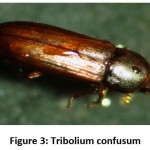 |
Figure 3: Tribolium confusum |
Description and Identifying Characters
The Head and thorax are Deep brown in colour while the abdomen is light brown in colour. They are elongated in shape and the body size ranges between 4mm -5 mm in length. Antennae are club shaped. These insects are often mistaken as the red flour beetles but they have a very distinctive body colour. They are relatively darker than the red flour beetles. Antennae are club shaped having anterior four lobes, unlike red flour beetle, which has three lobes.
Seasonal Availability: April – October. Pest Status: Secondary stored grain pest.
Damage
Both larvae and adults cause considerable damage to the stored grain commodities. High infestations lead to emission of foul smell, rotten and contaminated flour turns unfit for human consumption. Besides that, ecdysed skin and droppings can also be seen13.
Commodities/Products/Host Record
These were recorded on stored products like, wheat flour, semolina, biscuits and dry fruits. They may also infest sound grains.
Rhyzopertha dominica (Fabricius, 1792)
Common Name: Lesser Grain Borer (Fig. 4). Systematic Position: Order: Coleoptera; Family: Bostrichidae Distribution: Worldwide in distribution14.
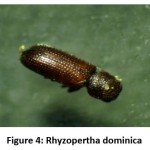 |
Figure 4: Rhyzopertha dominica |
Description and Identifying Characters
The adults are deep brown in colour measuring upto 3 mm in length. Antennae are long and club shaped that terminate into a tripartite club. Body is covered with crenulations all over. Head is concealed within the large pronotum (Prothorax) but abdomen is clearly visible and distinguishable. The abdomen is slightly tapering when viewed from the lateral side.
Seasonal Availability: March – November. Pest Status: Primary stored grain pest.
Damage
Larvae and adults both pose damage to the stored grains and deplete their nutritive content. They act as external as well as internal feeders15. It was observed that the adults and larvae produced heavy excreta along with frass from the grains making them highly unpalatable for humans. Besides attacking food grains, they were also found damaging the wooden structures like wooden kitchen equipment.
Commodities/Products/Host Record
These were recorded on wheat, rice, maize and wooden kitchen products. Besides, they are also recorded on millets, sorghum, cornflour, barley14, dry fruits, peanuts and spices16.
Oryzaephilus surinamensis (Linnaeus, 1758)
Common Name: Saw-toothed Grain Beetle (Fig. 5). Systematic Position: Order: Coleoptera; Family: Silvanidae Distribution: Worldwide in distribution4.
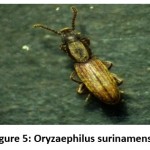 |
Figure 5: Oryzaephilus surinamensis |
Description and Identifying Characters
This is a small beetle and belongs to the family of flattened beetles. They are dull brown in colour with head and thorax a bit darker than the abdomen. Body size varies from 3mm – 4mm. Antennae are club shaped with three prominent anterior lobes. The body segmentation is distinctive where the thorax has a characteristic Saw-like appearance at the lateral side and hence the name “Saw-toothed grain beetle”. Six saw-tooth like extensions can be seen when viewed under stereomicroscope. Thorax appears depressed from the middle having longitudinal ridges. The insect is relatively slender and is a quick runner.
Seasonal Availability: February – November. Pest Status: Primary stored grain pest.
Damage
It is a minor pest of stored grains, yet, both adults and larvae are destructive in nature. They are external feeders and severely infect the whole grains particularly millets and processed products.
Commodities/Products/Host Record
Recorded on dry fruits, wheat flour, refined flour and onion seeds along with Tribolium castaneum, from the study area. Besides, they are also found in oilseeds, herbs, spices4, groundnuts, neem seed kernel and dates17.
Callosobruchus chinensis (Linnaeus, 1758)
Common Name: Pulse Beetle (Fig. 6). Systematic Position: Order: Coleoptera; Family: Chrysomelidae. Distribution: Worldwide in distribution18 but most common in Asia, Europe and North America11.
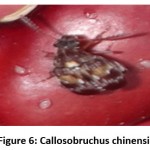 |
Figure 6: Callosobruchus chinensis |
Description and Identifying Characters
The adults are brownish in colour and measure about 5-7 mm in length with long, serrated antennae. The elytra consists of black markings on the outer edges of males while females have nearly spotless body. Longitudinal ridges are well marked on the elytra of this beetle that can be seen prominently using a stereomicroscope. Prefer damp and moist places.
Seasonal Availability: April – October. Pest Status: Primary stored grain pest.
Damage
The adults mainly damage by laying huge number of eggs on a single grain but the grubs do the major damage. The infestation usually happens very rapidly because there is no clue, which slot of pulses is infested and hence leads to mass emergence. During heavy infestations, every grain appears punctured by the emergence of adults and the grubs devour the grain from within, hence, the pulse becomes unpalatable.
Commodities/Products/Host Record
Recorded on pulses, kidney beans, chickpeas
Callosobruchus maculatus (Fabricius, 1775)
Common Name: Cowpea weevil (Fig. 7). Systematic Position: Order: Coleoptera; Family: Chrysomelidae Distribution: Worldwide in distribution19.
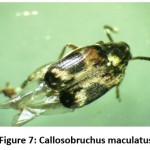 |
Figure 7: Callosobruchus maculatus |
Description and Identifying Characters
Body colour is light brown to dark brown in colour. Each measures about 4mm-5mm in length. The antennae are serrated. The adult males and females can be easily distinguished due the presence of unique pattern on the dorsal surface of the body. The Females have four black spots on the body out of which the middle two spot have white outline. The males have light, yet distinct spots on the body. Found in warm, damp and moist conditions. They live inside the grains until emergence.
Seasonal Availability: April – November. Pest Status: Primary stored grain pest.
Damage
Being internal feeders, they feed internally on the carbohydrate content of the seeds and create galleries inside the food item. During heavy infestations, it was noticed that when the adults emerge from the grain, they create a biting window for emergence and every grain appears punctured. The grains change colour and allow fungal attack as well.
Commodities/Products/Host Record
They were recorded on Chickpea, lentils, Soybeans & various pulses.
Callosobruchus analis (Pic, 1902)
Common Name: Pea weevil (Fig. 8). Systematic Position: Order: Coleoptera; Family: Chrysomelidae Distribution: Worldwide in distribution4.
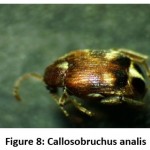 |
Figure 8: Callosobruchus analis |
Description and Identifying Characters
The adults are light brown to deep brown in colour, measuring about 3mm – 4mm in length. Mouthparts are biting and chewing type and serrated antennae. They differ from other two species discussed above in the way that these possess four markings on the upper side of the body that are smaller than C. maculatus and are not outlined with white markings.
Seasonal Availability: June – November. Pest Status: Primary stored grain pest.
Damage
They cause collective damage along with other Callosobruchus sp. They were found to feed on various pulses, chickpea, dried peas, etc. During heavy infestations, each grain appears punctured and becomes unpalatable for human consumption. They can actively compete with Callosobruchus chinensis and Callosobruchus maculatus due to competitive displacement20.
Commodities/Products/Host Record
They were recorded on cowpea, chickpea and pulses, from the study area.
Lasioderma serricorne (Fabricius, 1792)
Common Name: Cigarette Beetle (Fig. 9). Systematic Position: Order: Coleoptera; Family: Anobiidae Distribution: Worldwide in distribution Worldwide in distribution21, 22.
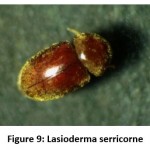 |
Figure 9: Lasioderma serricorne |
Description and Identifying Characters
Adult beetles are small, upto 2.5 mm – 3 mm in length and shiny reddish brown in colour. The head is small and hidden beneath the pronotum along with the antennae. The antennae are serrated, having a typical saw-like appearance. The elytra has a shiny appearance with golden yellow fine hair. They undergo a phenomenon called “Feigning Death”, where in, they act motionless when touched or disturbed.
Seasonal Availability: June – November. Pest Status: Primary and Secondary stored grain pest.
Damage
The larvae are the main reason for the damage of the stored products as compared to the adults. In most of the cases, the larvae make galleries inside the host food material and feed inside the commodities making them unfit for human consumption. They make cases, of the food material, for themselves where they pupate and undergo their development. Herbarium specimens are also damaged by these insects23, which directly feed on the plant parts and convert them into a powdery mass.
Commodities/Products/Host Record
From the study area, it was recorded on spices and pulse products. However, these are also found infesting cigarettes, tobacco leaves, cocoa, chocolate11, chamomile (Matricaria chamomilla)22, and processed cereal products. It also infects the herbarium specimens23.
Stegobium paniceum (Linnaeus, 1758)
Common Name: Drugstore Beetle (Fig. 10). Systematic Position: Order: Coleoptera; Family: Anobiidae Distribution: Worldwide in distribution Worldwide in distribution24, 11.
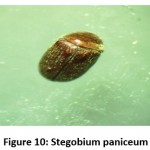 |
Figure 10: Stegobium paniceum |
Description and Identifying Characters
Slightly elongated and cylindrical in shape, measuring about 2.5 mm – 3.75 mm in length. Body colour is dull brownish to dull reddish. They also have concealed head beneath the pronotum. Antennae are club shaped, unlike Lasioderma serricorne, which has serrated antennae. The body contains fine lines and ridges that distinguish it from L. serricorne, however, golden yellow body hair are present all over the elytra.
Seasonal Availability: June – November. Pest Status: Primary and Secondary stored grain pest.
Damage
Larvae cause much damage by feeding on the stored products. They clump the food particles, spices, grains and seeds together and remain quiescent inside them until they emerge as adults, making the commodity unfit for consumption.
Commodities/Products/Host Record
From the study area, they were recorded on spices and pulses. They are also known to infest stored grains, seeds, packaged food products24, turmeric, ginger, pepper and other spices11. Besides stored products, it also attacks museum and herbarium specimens, medicinal plants and prescribed drugs25.
Sitophilus oryzae (Linnaeus, 1763)
Common Name: Rice Weevil (Fig. 11). Systematic Position: Order: Coleoptera; Family: Curculionidae Distribution: Worldwide in distribution26.
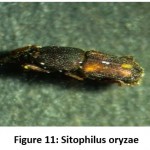 |
Figure 11: Sitophilus oryzae |
Description and Identifying Characters
It is small, upto 3 mm – 5 mm in length, reddish-brown to black in colour. It contains a long snout of about 1 mm length attached to which are a pair of Geniculate antennae. Characteristic four yellowish spots on the corners of elytra. The thorax and elytra are crenulated with longitudinal grooves.
Seasonal Availability: April – October. Pest Status: Primary stored grain pest.
Damage
This insect is a serious pest of stored grains that has originated from India and spread worldwide via trade and commerce. They were reported to damage, rice, maize, chickpea, cowpeas and peas. During heavy infestations, they destroy the seeds by converting them into flour and the destruction is much more than what they actually eat11.
Commodities/Products/Host Record
It was recorded on rice, wheat and maize, from the study area. Besides, it also feeds on oat, barley, rye, sorghum, dried beans and cashew nuts26.
Sitophilus zeamais (Motsch, 1855)
Common Name: Wheat weevil (Fig. 12). Systematic Position: Order: Coleoptera; Family: Curculionidae Distribution: Worldwide in distribution27.
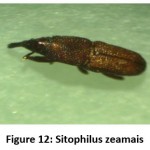 |
Figure 12: Sitophilus zeamais |
Description and Identifying Characters
The adult weevils are small about 3mm in length bearing a long snout. The body colour is dull brown. Geniculate antennae are present, attached to the base of the snout. The body colour is dull brown and the markings on the upper surface are not distinctly visible, although present. Body is crenulated with pits.
Seasonal Availability: June – October. Pest Status: Primary stored grain pest.
Damage
These insects are the major pests of stored grains. If left unattended, the grains starts emitting foul odour and become unhealthy for human consumption. They act as serious pests in the warehouses under tropical conditions.
Commodities/Products/Host Record
Recorded on wheat, rice and maize. Also, found to feed on sorghum, barley and oats 27, 28. They may also feed on some pulses.
Gibbium psylloides (Fabricius, 1777)
Common Name: Hump Spider Beetle (Fig. 13). Systematic Position: Order: Coleoptera; Family: Ptinidae Distribution: Worldwide in distribution29.
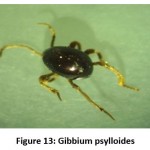 |
Figure 13: Gibbium psylloides |
Description and Identifying Characters
This beetle is small, shiny reddish brown in colour, globular, up to 4.5 mm in length and hairless. They have long legs that are pale yellow in colour, unlike the rest of the body. Antennae are long and hair-like i.e. Filamentous. Females are larger and more globular than males. These beetles look like Spider when viewed for the first time, hence, the name “Spider Beetles”. These insects are called as beetles resembling mites30.
Seasonal Availability: March- November. Pest Status: Secondary stored grain pest.
Damage
These act as minor pests and are usually found in the residues in storage structures. Fully-grown larvae (grubs) are destructive and tend to damage wooden items by boring deeply into them. During heavy infestations, the larvae spin silken thread like structure taking whole grains and attacked commodities underside it, thereby making them unpalatable.
Commodities/Products/Host Record
They were found to feed on the stored products like pulses, spices, dried fruits, spices, grains etc.
Cryptolestes ferrugineus (Stephens, 1831)
Common Name: Flat Grain Beetle (Fig. 14). Systematic Position: Order: Coleoptera; Family: Laemophloeidae Distribution: Worldwide in distribution4, 31, 32.
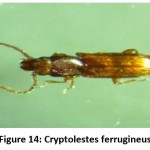 |
Figure 14: Cryptolestes ferrugineus |
Description and Identifying Characters
This insect is very small, measuring about 1mm – 2mm in length. These are reddish brown in colour, with very long filiform antennae. Antennae are about the size of the insect. Huge head, about 3/4th of the length of thorax is present. The head and thorax, together, makes up half of the total body length of the insect.
Seasonal Availability: March to Mid-December. Pest Status: Secondary stored grain pest.
Damage
Their infestation is not well known as they damage the grains along with other major pests like Tribolium sp. They are secondary pests, which infect the grains that are previously infested with primary pests like, Sitophilus sp. or Rhyzopertha dominica. They infest a large number of stored grain commodities4.
Commodities/Products/Host Record
Recorded on Refined flour and wheat flour from the study area. They are also found on dried processed foods, whole grains, nuts, oilseeds and cocoa4. Primary pest of wheat, but also feeds on barley capsicum, chilli, corns, dates, flax, mustard, oats, rice and sorghum32.
Plodia interpunctella (Hübner, 1813)
Common Name: Indian meal moth (Fig. 15). Systematic Position: Order: Coleoptera; Family: Pyralidae Distribution: Worldwide in distribution33.
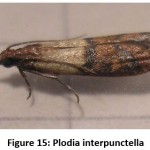 |
Figure 15: Plodia interpunctella |
Description and Identifying Characters
Adults are about 0.5-inch long, creamy coloured wings with copper coloured wing tips. Fore wing is about 7-9 mm in length. . The antennae are long and filiform. Copper coloured tips occupy almost half of the forewing. The head bears labial palps that are pointed forwards.
Seasonal Availability: July to November. Pest Status: Secondary stored grain pest.
Damage
Only larvae are the destructive stages that bore into the foodstuff, make tunnels and spin a silken thread as they move about the commodity, resulting in silken threads all over the attacked stored product. This makes the product highly unpalatable. Increased infestation leads to darkening and emission of foul odor from the commodities.
Commodities/Products/Host Record
They typically feed on milled, processed food, wide varieties of stored grains and dry fruits.
Corcyra cephalonica (Stainton, 1866)
Common Name: Rice moth (Fig. 16). Systematic Position: Order: Coleoptera; Family: Pyralidae Distribution: Worldwide in distribution4.
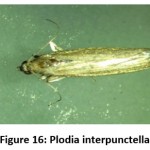 |
Figure 16: Corcyra cephalonica |
Description and Identifying Characters
The adults are light golden brown in colour, measuring about 6mm – 8mm lengthwise. The wingspan ranges between 10mm – 12mm, without distinctive markings. Antennae are filamentous shaped and mouthparts are siphoning type. Slightly shiny in appearance.
Seasonal Availability: July – November. Pest Status: Secondary stored grain pest.
Damage
Only the larvae are known to cause considerable damage by feeding on the host. They spin silken threads that cover the entire commodity and it becomes unpalatable for humans. Under heavy infestations, the flour fills with the excreted matter by the larvae and turns greyish, emitting foul smell.
Commodities/Products/Host Record
Recorded from rice and green pulse from the study area. Besides it is also found in dried vegetable material, dry fruits, nuts, chocolate, millet34, wheat, pearl millet, sorghum and maize35.
Ephestia cautella (Walker, 1863)
Common Name: Almond moth, Tropical warehouse moth (Fig. 17). Systematic Position: Order: Coleoptera; Family: Pyralidae Distribution: Worldwide in distribution36.
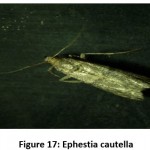 |
Figure 17: Ephestia cautella |
Description and Identifying Characters
The adult moth is Grey in colour with vague markings on the forewings, which also cover almost half of the fore wings. Total wingspan varies from 13-15 mm. Antennae are long and filamentous. The moth is very dull in appearance and the labial palps are curved upwards.
Seasonal Availability: July- December. Pest Status: Secondary stored grain pest.
Damage
Larvae being the most destructive stage bores into every commodity that is attacked by this pest. They also spin silken threads while moving about the infected area hence making the stored products unfit for human consumption.
Commodities/Products/Host Record
Recorded on dry fruits and wheat flour, grain and its products, nuts, herbs and spices. Serious pest of dates36 and confectionary items37.
Conclusion
The study is the first ever documentation of some economically important stored grain pests from Jammu district in Jammu and Kashmir. The study deciphered the diversity of 16 stored grain insects divided into two orders namely Coleoptera (81.25%) and Lepidoptera (18.75%). The results show that these two orders are the prime groups of insects responsible for the post harvest loss of stored grains with order coleoptera being the most dominant group. Despite their relevance to human health and well-being, we know relatively little about the insects that exist in our homes and the factors structuring their diversity. However, the present pilot study of these insects suggests that these relatively well-studied species represent a miniscule fraction of household insect diversity but the full extent of this diversity is much larger and even bigger when full scale investigations will be done in the entire Jammu region.
Acknowledgement
The authors are highly grateful to the Head, Department of Zoology, for providing necessary lab facilities and equipments. which have been parchased out of RUSA/DST PURSE/FIST grants.
Conflict of Interest
There are no conflict of interest.
Funding Sources
The authors are highly thankful to CSIR (UGC) NET-JRF grant for funding the research.
References
- Pruthi HS and Singh M. Pest of Stored Grains and their Control. 3rd Edition (Rev.). Indian Council of Agriculture Research (ICAR)”, Published by: Manager of Publications, Delhi. Printed by: Government of India Press, Calcutta, India, 1950.
- Khare BP. Pests of stored grain and their management. Kalyani Publishers, New Delhi, 1994; 304p.
- Cotton RT. Pest of stored grain on grain products. Burges comp. Minniapolis, Minn., 1960; 289p.
- Rees D. Insects of Stored Products. CSIRO Publishing, 2004; 1-146.
CrossRef - Weaver DK and Petroff AR. Pest management for Grain Storage and Fumigation. Montana Department of Agriculture, 2004; 1-36.
- Togola A, Seck PA, Glitho IA, Diagne A, Adda C, Toure A and Nwilene FE. Economic Losses from Insect Pest Infestation on Rice Stored on-farm in Benin. Journal of Applied Sciences, 2013; 13(2): 278-285.
CrossRef - Atwal AS and Dhaliwal GS. Agricultural Pests of South Asia and Their Management. Kalyani Publishers, 1999; 377-421.
- Shankar U and Abrol DP. Integrated Pest Management in Stored Grains. Insect Pest Management: Principles and Practice, 2012; 356-407.
CrossRef - Food and Agricultural Organization of the United Nation (FAO). INSECT DAMAGE: Post-Harvest Operations.
- Sharon MEM, Abirami CVK and Alagusundaram K. Grain Storage Management in India. Journal of Postharvest Technology, 2014; 2(1): 12-24.
- Bhargava MC, Choudhary RK and Jain PC. Advances in management of stored grain pests. Entomology: Novel Approaches. New India Publishing Agency, New Delhi, 2007; 425-451.
- Baldwin R and Fasulo TR. Confused Flour Beetle, Tribolium confusum Jacquelin du Val (Insecta: Coleoptera: Tenebrionidae) and Red Flour Beetle, Tribolium castaneum (Herbst) (Insecta: Coleoptera: Tenebrionidae). EENY289, Department of Entomology and Nematology, UF/IFAS Extension, Gainesville, FL32611, 2003; 1-5.
- Mohammad OS, Ali WK and Al-Hulitan AT. The effect of infestation by the Confused Flour Beetle (Tribolium confusum ) on Specifications of Wheat Flour. Journal of Agricultural Science and Technology, 2012; A(2): 696-701.
- Pires EM and Nogueira RM. Damage caused by Rhyzopertha dominica (Fabricius, 1792) (Coleoptera: Bostrichidae) in stored Brazil Nuts. Sci. Elec. Arch., 2018; 11(1): 57-61.
- Majeed MZ, Mehmood T, Javed M, Sellami F, Riaz MA and Afzal M. Biology and management of stored products’ insect pest Rhyzopertha dominica (Fab.) (Coleoptera: Bostrichidae). Int. J. Biosci., 2015; 7(5): 78-93.
CrossRef - Koehler PG and Pereira RM. Lesser Grain Borer, Rhyzopertha dominica (Coleoptera, Bostrichidae). ENY- 264, Department of Entomology and Nematology, UF/IFAS Extension, Gainesville, FL 32611, 1994; 1-2.
- Govindaraj R, Mohankumar S, Rajasekaran B and Mohan S. Biology of the sawtoothed grain beetle, Oryzaephilus surinamensis (Linnaeus) on different stored products and its host associated genetic variability. 11th International Working Conference on Stored Product Protection, Chiang Mai, north Thailand, 2014; 128-135.
- Thakur AK and Pathania M. Biology of Pulse Beetle (Callosobruchus chinensis) and Its Management through Plant Products on Black Gram (Vigna mungo). Science, Technology and Arts Research Journal, 2013; 2(1): 18-21.
CrossRef - Muhammad A and Bashir AK. Callosobruchus maculatus (Fab.) control by plant products in cowpea grains under storage: A review. Journal of Medicinal Botany, 2017; 1: 51-57.
CrossRef - Haines CP. Observations on Callosobruchus analis (F.) in Indonesia, including a key to storage Callosobruchus spp (Col., Bruchidae). Journal of Stored Products Research, 1989; 25(1): 9-16.
CrossRef - Cabrera BJ. Cigarette Beetle, Lasioderma serricorne (F.) (Insecta: Coleoptera: Anobiidae), EENY-227, Entomology and Nematology Department, Ft. Lauderdale REC, UF/IFAS Extension, Ft. Lauderdale, FL 33314, 2001a; 1-5.
- Zanuncio JC, Tavares WDS, Faroni LRD, Wilcken CF and Serrao JE. Lasioderma serricorne (Coleoptera: Anobiidae) in Stored Matricaria recutita (Asteraceae) in Brazil. Florida Entomologist, 2014; 97(2): 807-808.
CrossRef - Retief E and Nicholas A. The cigarette beetle Lasioderma serricorne (F.) (Coleoptera: Anobiidae): a serious herbarium pest. Bothalia, 1988; 18(1): 97-99.
CrossRef - Cabrera BJ. Drugstore Beetle, Stegobium paniceum (L.) (Insecta: Coleoptera: Anobiidae), EENY- 228, Entomology and Nematology Department, Ft. Lauderdale, REC, UF/IFAS Extension, Ft. Lauderdale, FL 33314, 2001b; 1-4.
- Abdelghany AY, Awadalla SS, Abdel-Baky NF, El-Syrafi HA and Fields PG. The control of the drugstore beetles, Stegobium paniceum (Coleoptera: Anobiidae) with high and low temperatures”, 10th International Working Conference on Stored Product Protection, Portugal, Julius-Kuhn-Archiv, 2010; 425: 671-672.
- Koehler PG. Rice weevil, Sitophilus oryzae (Coleoptera: Curculionidae). EENY261, Department of Entomology and Nematology, UF/IFAS Extension, Gainesville, FL 32611, 1994; 1-2.
- Ojo JA and Omoloye AA. Development and Life History of Sitophilus zeamais (Coleoptera: Curculionidae) on Cereal Crops. Advances in Agriculture, 2016; Vol. 2016: 1-8.
CrossRef - Suleiman M, Ibrahim ND and Majeed Q. Control of Sitophilus zeamais (Motsch) [Coleoptera: Curculionidae] on Sorghum using Some Plant Powders. International Journal of Agriculture and Forestry, 2012; 2(1): 53-57.
CrossRef - Belles X and Halstead DGH. Identification and geographical distribution of Gibbium aequinoctiale Boieldieu and Gibbium psylloides (Czenpinski) (Coleoptera: Ptinidae). Journal of Stored Products Research, 1985; 21(3): 151-155.
CrossRef - Lefroy HM. Indian Insect Pests. Calcutta: Office of the Superintendent of Government Printing, India, 1906.
- Thomas MC. A Revision of the New World Species of Cryptolestes (Ganglbauer) (Coleoptera: Cucujidae: Laemophloeinae). Insecta Mundi, 1988; 2(1): 43-65.
- Ozgen I. Yucel A and Karsavuran Y. The first findings on rusty grain beetle, Cryptolestes ferrugineus (Stephens, 1831) (Coleoptera, Cucujoidea: Laemophloeidae) in pistachio orchard in Siirt province (Turkey). Int J Agric Environ Food Sci, 2018; 2(2): 57-58.
CrossRef - Fasulo TR and Knox MA. Indianmeal Moth, Plodia interpunctella (Hubner) (Insecta: Lepidoptera: Pyralidae). EENY-026, Entomology and Nematology Department, UF/IFAS Extension, Gainesville, FL 32611, 1998; 1-4.
- Jagadish PS, Nirmala P, Rashmi MA, Hedge JN and Nangia N. Biology of rice moth, Corcyra cephalonica Stainton on foxtail millet. Karnataka J. Agric. Sci., 2009; 22(3): 674-675.
- Bhardwaj JR, Ganguli JL, Khan HH and Sahu R. Bionomics of the rice meal moth, Corcyra cephalonica (Stainton) reared under laboratory condition on different diets. Journal of Entomology and Zoology Studies, 2017; 5(5): 722-727.
- Aldawood AS, Rasool KG, Alrukban AH, Soffan A, Husain M, Sutanto KD and Tufail M. Effects of Temperature on the Development of Ephestia cautella (Walker) (Pyralidae: Lepidoptera): A Case Study for its Possible Control Under Storage Conditions. Pakistan J. Zool., 2013; 45(6): 1573-1578.
- Salvodelli S and Suss L. Integrated control of Ephestia cautella (Walker) in a confectionary factory. 10th International Working Conference on Stored Product Protection, Portugal, 2010; 991-992.

This work is licensed under a Creative Commons Attribution 4.0 International License.





